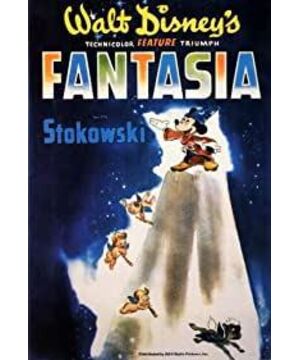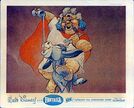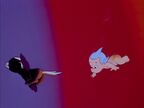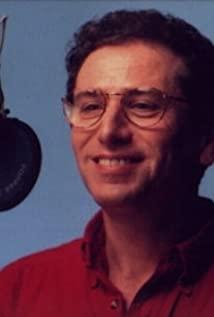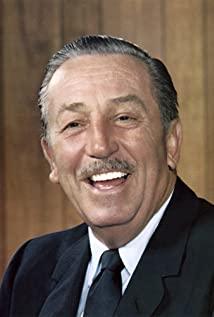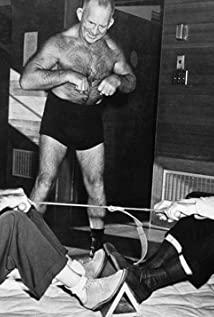Walt Disney talked about this plan with the well-known Polish conductor Leopold Stokowski at a dinner. The two hit it off, and the latter also readily agreed to serve as the front-screen conductor for Disney for free. The repertoire they collaborated on is the French composer Paul Ducasse's symphonic scherzo "The Magician's Apprentice". Dukas is the teacher of my country’s famous musician Xian Xinghai. This work is based on Goethe’s narrative poem of the same name. The best choice.
In 1938, Walt Disney ordered the production of "The Wizard's Apprentice". This short film was 9 minutes long, which was 2 minutes longer than the average animation short film. The film’s style is luxurious, and the animator Fred Moore even painted Mickey Mouse’s eyes with pupils to make it look more attractive. The cost of the film is as high as 120,000 US dollars (at this time, the production cost of a general Disney animation short film is 40,000 US dollars, while the average production cost of short films by animation companies other than Disney is less than 10,000 US dollars). It’s difficult to recoup the cost of the film’s front screening format (Disney’s most profitable short film "The Three Little Pigs" has a profit of only 60,000 US dollars), and the Philadelphia Orchestra under Stokowski’s expenses far exceeded the budget. Therefore, Stokowski proposed to record multiple pieces of music to reduce costs. Walt Disney could only make preparations for filming an animated feature film. The two jointly selected suitable classical music to be adapted, and invited senior music critic Di Ms. Taylor serves as the commentator for the film temporarily named "The Concert."
After some deliberation, all the tracks were finally finalized. In addition to "The Sorcerer's Apprentice", it also includes Bach's "Toccata and Fugue in D minor", Lao Chai's "The Nutcracker", Stravinsky's "The Rite of Spring", and Beethoven's "Pastoral Symphony" "Music", Ponzielli's "Dance of Time", Mussorgsky's "Night in the Barren Mountain" and Schubert's "Ode to the Virgin". Disney also decided to use the free soaring title "Fantasia" to officially name the new film. What was unexpected to Disney was that when "Fantasia" was completed, the cost had already exceeded $2.28 million.
The film combines animation with classical music. It is an ambitious experimental work in the history of mainstream animation. It seems that many scenes are still imaginative and shocking. Herman Schultheis is responsible for the production of special effects for the film. Animation also needs special effects production? That's right, for some shots that seem to be easy to complete with computer animation today, at the time, they had to be solved by manual special effects instead of brushes.
For example, the lens of the falling snowflakes at the end of The Nutcracker
is actually made of gears and a small train track. The snowflakes are carved out. The transparent snowflakes rotate through the planetary motion and move along the small track toward the front of the camera. When shooting, the camera tipped so that we could see a close-up of the snowflakes at the end. Before shooting each frame, the track is covered with black velvet. These real-life images are finally synthesized with the animated images of the Snow Fairy drawn by the animator. The two different elements are thus combined in the finished image.
Since the scene and camera will be reset after the shooting of each special effects lens, HermanSchultheis made a detailed record of the production methods and sketches of these special effects. Not only is there all the special effects production methods in the notebook, but he also let people I took pictures of actual operations at the scene.
Most of the special effects are shot frame by frame, which is time-consuming and labor-intensive. HermanSchultheis eats and lives in the studio. A week before the film was released, he was still shooting non-stop, and there was an earthquake when it was about to be completed. , But he finally overcame all difficulties and caught up with the premiere.
HermanSchultheis didn't realize the value of this notebook, so after he finished the film, he planned to sell it to Disney at a price of $400, but at the time Walt Disney didn't want to buy it because it didn't have much value. He can only hide the notebook at home, and leave it for decades.
In 1955, Herman Schultheis went on a trip to Guatemala. He disappeared from the world after walking into the jungle. He has since disappeared and is believed to have died in the jungle many years later. When his wife died in her 90s, she left the property to the nursing nun, and found that there were some books under the bed that were signed by Disney to give to Herman Schultheis, so she called the people at Disney and wanted to give them.
Disney's animation expert Howard Rowley saw this notebook when he was sorting out these relics. His heartbeat was quickening and he was a treasure, because even in Disney, everyone didn't know how the special effects of "Fantasia" were made. of. In other words, without this notebook, many animation special effects are still a mystery today, and an important chapter in the history of animation special effects would not be able to be written.
The preservation of the notebook is very bad. The glue on the paper has expired, and the pasted items are scattered. Disney immediately carried out a digital scan and comprehensive repair of the notebook. The newly produced notebook was made into a digital format and placed in Disney. The family museum is for visitors and scholars to appreciate and study.
If you are interested in this special effects story, you can find more interesting behind-the-scenes stories about the "Fantasia" in the full-Chinese version of "Fantasia" Blu-ray Highlights released by Guangdong Taisheng Culture Company in March 2011.
Original address: http://i.mtime.com/film101/blog/5894945/
View more about Fantasia reviews


